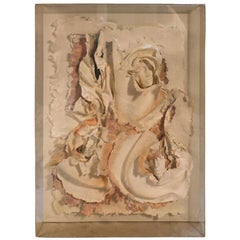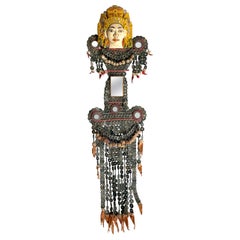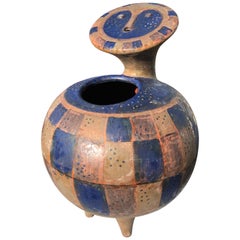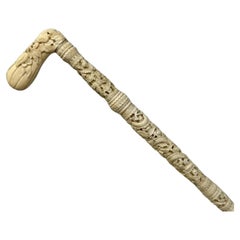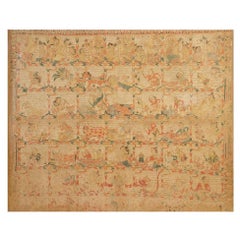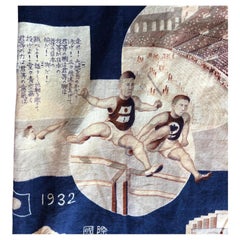Cotton Sculptures and Carvings
to
2
2
2
1
22,990
1,699
1,101
915
786
1
1
1
1
1
2
2
2
Material: Cotton
Marcia Mazur-Gold and Ross Mazur Midcentury Handmade Paper Sculpture
Located in Baltimore, MD
Artist: Ross Mazur, American and Marcia Mazur-gold, American
Medium: Handmade paper, pressed cotton fiber collage sculpture in Plexi-case, signed in pencil “Marcia Gilbert Mazur”
Measurements: 44 5/8? H x 5 3/8? D x 34 3/8? W
Condition report: Minor age appropriate handling wear. Original Plexi-case frame with some cracks small piece of plexi missing in lower corner (frame overall of very fine quality and condition). Overall remaining in outstanding presentation– good condition.
Ross Mazur was born and raised in Chicago. After receiving a scholarship at the Chicago Art Institute, he enjoyed a 20-year career as an illustrative photographer, bringing to the industry many original and innovative techniques still in use today.
Ross Mazur has been a full-time working artist all his life. Since the 1980s he has focused his creative endeavors painting, shaping and embellishing handmade pulp paper. This kind of art can be hard, but satisfying, work. The end result of this effort is an interesting combination of production processes from raw materials to finished art pieces. In 2002, Marcia and Ross completed a video segment for the PBS series “The Artist’s Workshop”.
Ross was introduced to paper art by his wife Marcia Mazur-Gold, who died 2004, but before her death they collaborated on the creation of mixed media compositions. They had been working as a team on and off since 1971 and began working in paper in 1981 when Marcia took a papermaking workshop at the famous Ox Bow Art School in Michigan. Drawn to his wife’s creative work, Ross quickly left his clay work and other art behind.
By 1980s Ross owned a gallery on the North Shore in Chicago which he ran for four years but then moved on to do mainly art expos and festivals around the country including New York City. In 1986, the Mazurs showed their work at the Los Angeles Art Expo and stopped off in Sedona. Two weeks later they bought a house here and built their studio.
They also maintained a studio in Miami and, for a while, in Michigan, which gave them an opportunity to work closer to the main art festivals where they sold their work. Where they went really all depended on where the collectors of their art went. Moving around the country, with the Mid-West in the summer, and Florida in the winter, with the Arizona art festivals in between, became a way of life. Here in Arizona, Ross participated in art festivals in Sedona, Tempe, Scottsdale, Tucson and Fountain Hills.
In 1991 Mazur’s work took a turn toward Native American motif although his paper sculptures, both free-standing and for the wall, remained abstract. He also removed the Lucite framing that encased the paper art. This change dramatically altered the way the paper art was perceived, especially here in Arizona. It sells extremely well. Just as Ross loves the tactile nature of this medium, perhaps his collectors also feel the need to be close to the art without impediments such as Lucite cases.
At the present time Ross is working on a series of sculptural compositions for the wall as well as free standing sculptures. These pieces are composed of a pressed cotton fiber matrix, utilizing the process of handmade paper.
Mazur has participated in the Sedona Art...
Category
20th Century American Cotton Sculptures and Carvings
Materials
Cotton, Plexiglass, Paper
Rare Large Antique Balinese Temple Hanging Lamak, Indonesia
Located in Atlanta, GA
An extraordinary "Kepeng Lamak" from Bali, Indonesia, circa early 20th century. Lamak is a general term for temple hangings, mostly made of disposable materials like palm leaves for temporary offerings. A small number, such as this piece, were made by wealthy and aristocratic families for permanent display. The lamaks are traditionally displayed in temples or residents for a strong spiritual reason in Bali that is known as "Artja". They could function as receptacles, or a vessels of for the habitation of the deities when they descent to the earth on propitious occasions.
In a goddess form with a carved wood head adorned with painted face and mirrored crown who likely represents Dewi Danu, the water goddess, this lamak was constructed with a bamboo frame, cotton pompoms, fabric fragments...
Category
Early 20th Century Indonesian Other Cotton Sculptures and Carvings
Materials
Copper
Related Items
Bold Master Work Handmade and Hand Glazed, Eva Fritz-Lindner, Unique
Located in South Burlington, VT
This is a fine and unusual handmade, hand painted and hand glazed Mid-Century Modern ceramic anthropomorphic effigy of a round form by the now deceased master designer Eva Fritz-Lind...
Category
Mid-20th Century German Mid-Century Modern Cotton Sculptures and Carvings
Materials
Ceramic, Pottery
$400 Sale Price
78% Off
H 12 in Dm 8 in
Antique Victorian Vintage Chinese Ivory Bovine Walking Stick Cane Carved Dragon
Located in Dublin, Ireland
An Exceptionally Fine Example of a Chinese Export Hand Carved Bovine Ivory Walking Stick of small proportions, last quarter of the Nineteenth Centu...
Category
Late 19th Century British Victorian Antique Cotton Sculptures and Carvings
Materials
Horn, Ebony
$1,167
H 25.75 in W 2.75 in D 25.75 in
Chinese Jade Top Matchbox Holder, c. 1930
Located in Chicago, IL
With vintage charm and petite scale, this Chinese matchbox holder features an openwork jade lid carved to depict flowers and foliage in translucent green. The jade panel is removable...
Category
Early 19th Century Chinese Antique Cotton Sculptures and Carvings
Materials
Jade, Brass
Vintage Traditional Japanese Kokeshi Wood Doll
Located in North Hollywood, CA
Kokeshi or Kokashi doll handmade by Japanese artisans from wood.
The dolls have a simple trunk as a body and an enlarged head.
One characteristic of Kokeshi dolls is their lack of arms and legs.
signed underneath as follow.
Kokashi Doll Kegon Waterfall Japan 1987.
Kokeshi (???, ???), are simple wooden Japanese dolls with no arms or legs that have been crafted for more than 150 years as a toy for...
Category
Late 20th Century Japanese Japonisme Cotton Sculptures and Carvings
Materials
Wood
Chinois green Bi Celadon Disc Sculpture, Mineral and forging
By Dynasty Transorient
Located in Valladolid, ES
Celadon Bi Disc Sculpture, Mineral and Forging, 20th century – China
Exquisite and sophisticated Bi disc made in the early 20th century in China. It is an extraordinary disc carved ...
Category
1940s Chinese Qing Vintage Cotton Sculptures and Carvings
Materials
Stone, Wrought Iron
$756 Sale Price
20% Off
H 18.12 in W 14.18 in D 5.12 in
Antique Indian Dhokra Horse and Rider Sculpture
Located in Dallas, TX
Presenting a lovely antique Indian Dhokra horse and rider sculpture.
Probably from the late 19th or early 20th century as is evidenced by its natural patina and clear evidence of age.
It depicts an Indian Warrior with a sword in his right hand mounted on his horse/steed.
The warrior is in classical and ancient Southeast Asian Indian attire and he holds the horse’s reins in his left hand.
The body of the horse is a series of lines (in the Classic Dhokra Style) and it has a tribal headdress...
Category
Late 19th Century Indian Anglo Raj Antique Cotton Sculptures and Carvings
Materials
Metal
Japanese Art Deco Sculpture Lioness and Gazelle
Located in Douglas Manor, NY
3-541 Japanese Art Deco Folk Art hand carved sculpture of a lioness and its gazelle prey.
Category
1940s Vintage Cotton Sculptures and Carvings
Materials
Ebony
Chinese Carved and Painted Wood Sculpture of Guanyin
Located in Stamford, CT
Beautiful carving of Guanyin, shown standing on a rocky outcrop, mounted on a lobed wooden base. It was once used as a lamp, and can be rewired. Nice faded painted surface.
Guany...
Category
Early 20th Century Chinese Ming Cotton Sculptures and Carvings
Materials
Wood
Antique Gnome Sculpture "Digging For Gold" Original Paint
Located in South Burlington, VT
Digging For Gold- Rare Form
Gardener's Best Friend - As American as Apple Pie
An American garden friendly elf or gnome- hand cast double sided form and hand painted. Imagine this fellow going about his business digging in your garden - perhaps burying gold treasure...
Category
Early 20th Century American Folk Art Cotton Sculptures and Carvings
Materials
Iron
$760 Sale Price
72% Off
H 13.35 in W 5.5 in D 3.25 in
15-16th Century Sandstone Standing Buddha Sculpture
Located in Kastrup, DK
400-500 years old hand carved sandstone sculpture of a standning Buddha flanked by a munk and a mythical animal.
Originates from pagoda / temple in Ara...
Category
16th Century Burmese Other Antique Cotton Sculptures and Carvings
Materials
Sandstone
Japanese Antique Collection 50 Hand Carved Fishing Lures Angler's Delight Signed
Located in South Burlington, VT
Anglers Collection Fifty (50) Antique Hand Carved And Signed Wood Fishing Lures- Rare Find
A museum collection complete with original antique wooden collector lacquered cabinet , kodansu
An unusual one-of-a-kind find collection consisting of fifty (50) Japanese antique fishing lures...
Category
Early 20th Century Japanese Taisho Cotton Sculptures and Carvings
Materials
Metal
$1,550 / set
H 12 in W 13.5 in D 9 in
Japanese Antique Pair Large Red And Gilt Elephant And Lion Temple Benches, 1925
Located in South Burlington, VT
Here's a wonderful find from our acquisitions trip to Japan.
We were fortunate to find this Art Deco period pair (2) matching hand-carved, hand red lacquered and gilt embellished temple wooden benches. The white elephant bench and matching shi-shi komainu temple lion both originally came from a temple near Kobe. Quite sturdy, they may have been entry sitting or shoe changing benches...
Category
Early 20th Century Japanese Taisho Cotton Sculptures and Carvings
Materials
Wood, Lacquer, Textile
$4,900 / set
H 20 in W 33.5 in D 22 in
Previously Available Items
Antique Balinese Calendar, Palelintangan, Kamasan, Bali, early 20th century
Located in Point Richmond, CA
Antique Balinese Calendar, Palelintangan, Kamasan, Bali, early 20th century, known as "tabing plintangan", a large rectangular plain weave natural co...
Category
20th Century Balinese Folk Art Cotton Sculptures and Carvings
Materials
Cotton
H 54.5 in W 66.5 in D 2.5 in
Rare 1930 Olympic Sports Kimono Fine Condition
Located in South Burlington, VT
First We Have Seen.
Unique Sports Collectible Opportunity- Immediately Frameable
"Happi with International Olympic athletes sending off cheering son...
Category
Early 20th Century Japanese Showa Cotton Sculptures and Carvings
Materials
Cotton
Japanese Gigantic 26 Foot Old Children's Day Koi Flag, Hand-Painted
Located in South Burlington, VT
From our recent Japanese Travels
Japanese an unusually long, gigantic Old Children's Day Koi Flag, -Koinobori-, measuring a whopping 320", or 26 feet in length and 5 feet in width.
Hand painted on heavy quality cotton in blued, white, red, and black colors.
Children's Day , Kodomo no Hi, is a Japanese national holiday which takes place annually on May 5 and is the final celebration in Golden Week. It is a day set aside to respect children's personalities and to celebrate their happiness. It has been a day of celebration in Japan since ancient times. Until 1948, Children's Day was known as Boys' Day (also known as Feast of Banners) while Girls' Day (Hinamatsuri) was celebrated on March 3. At that time, the government decreed this day to be a national holiday to celebrate the happiness of all children and to express gratitude toward mothers. It was renamed Kodomo no Hi.
Koinobori (鯉のぼり), means "carp streamer" in Japanese, are carp-shaped windsocks traditionally flown in Japan to celebrate Tango no sekku (端午の節句), national holiday; Children's Day (Kodomo no Hi, 子供の日). These wind socks...
Category
Early 20th Century Japanese Taisho Cotton Sculptures and Carvings
Materials
Cotton
Japanese 1930s Los Angeles Olympic Commemorative Kimono, Rare Collectible Chance
Located in South Burlington, VT
Rare Olympic Collectible Opportunity
"Happi with International Olympic athlete sending off cheering song for 1932 Los Angles Olympics"
This is...
Category
Early 20th Century Japanese Edo Cotton Sculptures and Carvings
Materials
Cotton
H 49 in W 49 in D 0.01 in
Japanese Fine Antique Samurai Indigo Dyed "Haori" Jacket, Immediately Frameable
Located in South Burlington, VT
An exceptionally fine quality Japanese fine antique samurai blue indigo dyed Haori jacket, late Edo period 18th-19th century.
Displays important decoratio...
Category
Mid-19th Century Japanese Edo Antique Cotton Sculptures and Carvings
Materials
Cotton
H 39.25 in W 52 in D 0.01 in
Read More
12 Calming Spaces Inspired by Japanese Design
From cherry-blossom-adorned walls paired with glamorous lighting to wood-paneled ceilings above checkerboard-patterned chairs, these 12 spaces seamlessly blend Eastern and Western aesthetics.
Rodrigo Rivero Lake’s Mexico City Showroom Is a Museum-Worthy Trove of Spanish Colonial and Asian Antiques
The dealer and curator has spent the past 50 years amassing a collection of exceptional art, furniture and architectural elements that trace the cultural influence of the Spanish empire from Europe to the Americas and beyond.
Recently Viewed
View AllMore Ways To Browse
Ming Dynasty Figures
Japanese Garden Basins
Jade Carving On Stand
Monk Head
Hands Up Buddha
Japan Temple Flowers
Japanese Garden Seats
Lotus Flower Buddhist
Japanese Root
Large Carved Wood Buddha
Jade Bamboo
Happy Buddha
Japanese Edo Buddha
Japanese Wood Trunk
Marble Sculpture Buddha
Japanese Altar
Japanese Stone Basin
Japanese Wood Lantern
